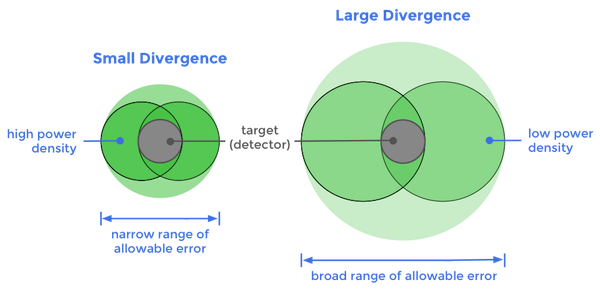Difference between revisions of "Precision Aiming"
Ehillstrom (talk | contribs) m |
Smaldonado (talk | contribs) (Changed image align to right) |
||
| (3 intermediate revisions by 2 users not shown) | |||
| Line 1: | Line 1: | ||
| − | If the [[beam divergence]] of a transmitter is small, i.e. it forms a tighter cone, then more power actually reaches the receiver. However, low divergence means that the beam must be very well aligned for the spot to actually coincide with the receiver aperture. By contrast, if the transmit beam is wider, the spot becomes larger and it is easier to hit the receiver, but less power will be transmitted into the receiver system. This tradeoff is an ongoing high-level design question for SSI's OpComms team. | + | [[File:PrecisionAiming.png|frame|right]] |
| + | |||
| + | If the [[beam divergence]] of a transmitter is small, i.e. it forms a tighter cone, then more power actually reaches the receiver. However, low divergence means that the beam must be very well aligned for the spot to actually coincide with the receiver aperture. By contrast, if the transmit beam is wider, the spot becomes larger and it is easier to hit the receiver, but less power will be transmitted into the receiver system. This tradeoff is an ongoing high-level design question for SSI's [[OpComms]] team. | ||
Precision pointing is arguably the greatest challenge in satellite optical communications. Given the extremely long distances involved, extremely accurate pointing is required to achieve a link of sufficient power. For example, the ESA [[ARTEMIS and SPOT-4]] inter-satellite link required a pointing error of less than 10 microradians [https://directory.eoportal.org/web/eoportal/satellite-missions/s/spot-4] and NASA’s [[LLCD]] was designed to have a pointing stability of just 4 microradians . Achieving this kind of precision with a mechanism that must withstand the shock and vibrations levels of launch and payload deployment is even more difficult. | Precision pointing is arguably the greatest challenge in satellite optical communications. Given the extremely long distances involved, extremely accurate pointing is required to achieve a link of sufficient power. For example, the ESA [[ARTEMIS and SPOT-4]] inter-satellite link required a pointing error of less than 10 microradians [https://directory.eoportal.org/web/eoportal/satellite-missions/s/spot-4] and NASA’s [[LLCD]] was designed to have a pointing stability of just 4 microradians . Achieving this kind of precision with a mechanism that must withstand the shock and vibrations levels of launch and payload deployment is even more difficult. | ||
It is likely not technically feasible to achieve this level of pointing precision in a CubeSat in the near future, however there is a lot of promising work in this field. One CubeSat components manufacturer, for example, is offering a CubeSat bus that claims +/- 0.002 degree (34.9 microradian) pointing accuracy with 1 arc second stability [http://bluecanyontech.com/wp-content/uploads/2015/05/XB1-Data-Sheet_1.0.pdf]. | It is likely not technically feasible to achieve this level of pointing precision in a CubeSat in the near future, however there is a lot of promising work in this field. One CubeSat components manufacturer, for example, is offering a CubeSat bus that claims +/- 0.002 degree (34.9 microradian) pointing accuracy with 1 arc second stability [http://bluecanyontech.com/wp-content/uploads/2015/05/XB1-Data-Sheet_1.0.pdf]. | ||
| + | |||
| + | [[Category:Optical Communications]] | ||
Latest revision as of 11:03, 5 December 2015
If the beam divergence of a transmitter is small, i.e. it forms a tighter cone, then more power actually reaches the receiver. However, low divergence means that the beam must be very well aligned for the spot to actually coincide with the receiver aperture. By contrast, if the transmit beam is wider, the spot becomes larger and it is easier to hit the receiver, but less power will be transmitted into the receiver system. This tradeoff is an ongoing high-level design question for SSI's OpComms team.
Precision pointing is arguably the greatest challenge in satellite optical communications. Given the extremely long distances involved, extremely accurate pointing is required to achieve a link of sufficient power. For example, the ESA ARTEMIS and SPOT-4 inter-satellite link required a pointing error of less than 10 microradians [1] and NASA’s LLCD was designed to have a pointing stability of just 4 microradians . Achieving this kind of precision with a mechanism that must withstand the shock and vibrations levels of launch and payload deployment is even more difficult.
It is likely not technically feasible to achieve this level of pointing precision in a CubeSat in the near future, however there is a lot of promising work in this field. One CubeSat components manufacturer, for example, is offering a CubeSat bus that claims +/- 0.002 degree (34.9 microradian) pointing accuracy with 1 arc second stability [2].
